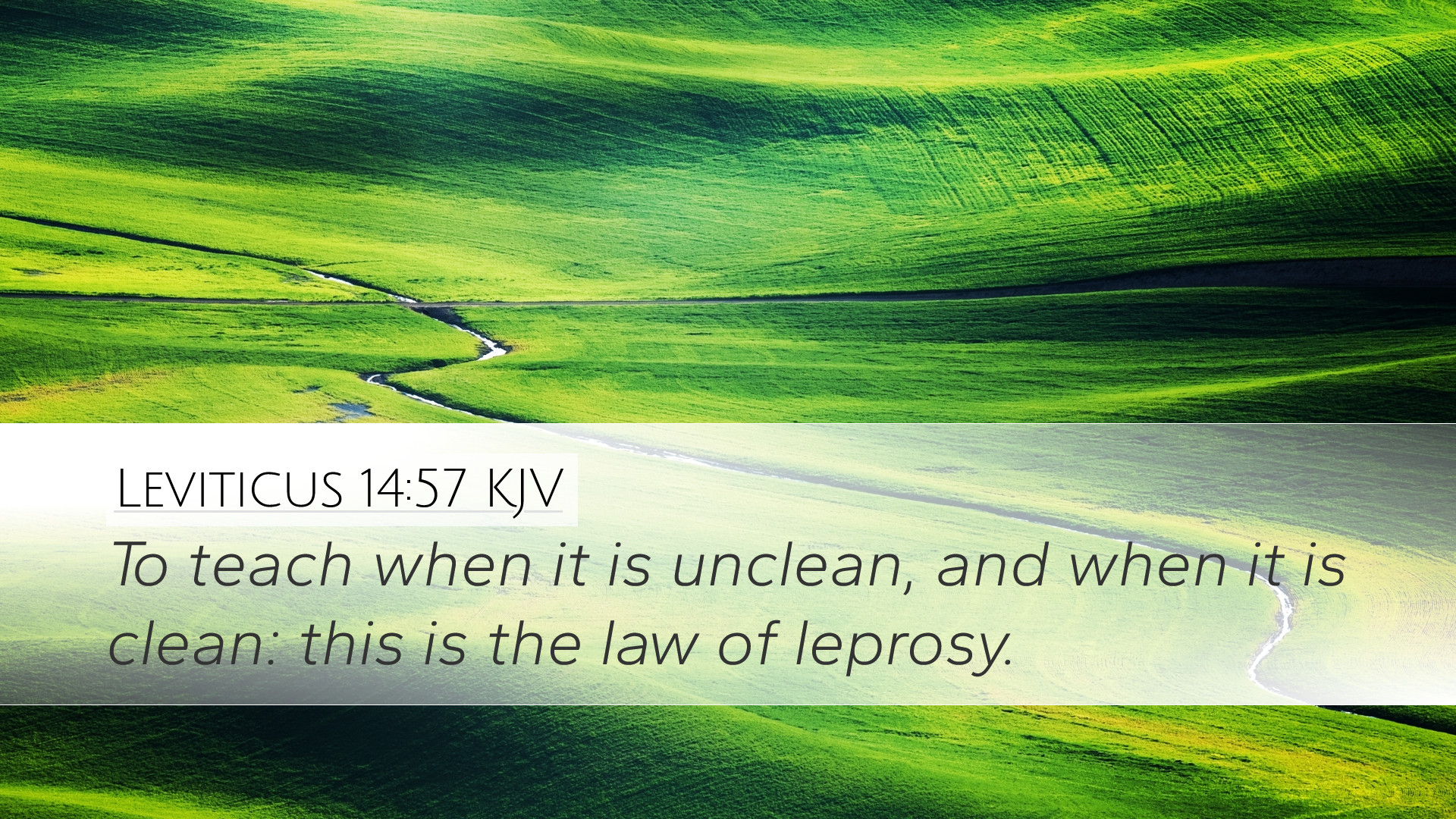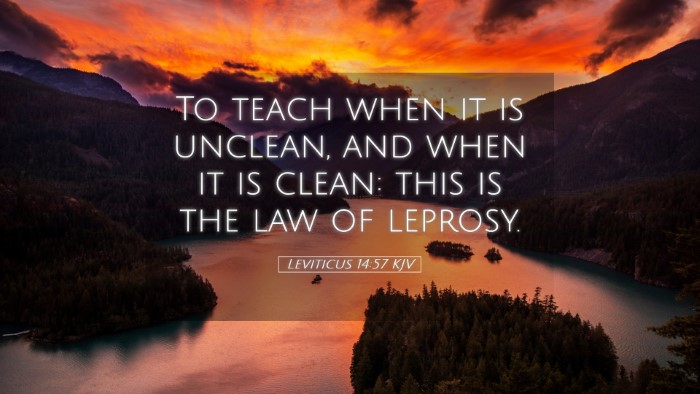Commentary on Leviticus 14:57
Leviticus 14:57 states: "And for the law of leprosy, and for a leprous garment, and for a leprous house, and for a rising, and for a scab, and for a bright spot: to teach when it is unclean, and when it is clean: this is the law of leprosy." This verse serves as a closing instruction regarding the laws governing ceremonial cleanliness concerning leprosy, garments, and houses.
Contextual Background
The book of Leviticus, primarily focused on the laws and regulations for the priests and the Israelites, outlines instructions from God about holiness and cleanliness. The concept of leprosy in biblical times was not just a physical ailment but also had ecclesiastical implications, where the afflicted had to adhere to certain rituals to maintain community purity.
Historical Significance
- Matthew Henry: Comments on how the laws concerning leprosy signify God's concern for both physical ailments and spiritual purity. They serve as reminders of sin's pervasive effects and the need for divine cleansing.
- Albert Barnes: Notes that the laws were intended to guide the Israelites in distinguishing what is clean from what is unclean, stressing that spiritual health is tied to physical conditions.
- Adam Clarke: Emphasizes that these regulations represent a profound understanding of health, hygiene, and morality at the time, correlating cleanliness in physical terms with spiritual conditions.
Thematic Analysis
The verse underlines several themes critical to the theological understanding of leprosy:
- Purity and Holiness: The laws demonstrate that physical impurities are a symbolic representation of spiritual states before God. The Jewish tradition of rituals reflects a deeper relationship with God and the maintenance of holiness among His people.
- Community and Isolation: The afflicted were often isolated, signifying the seriousness of sin. This concept of isolation serves to highlight the sinfulness that separates humanity from God.
- Divine Instruction: God provides laws for His people to teach them discernment between purity and impurity, emphasizing the importance of adhering to His commandments for spiritual health.
Interpretative Insights
- Matthew Henry: Suggests that understanding these laws and their implications teaches believers the need for vigilance in moral and spiritual conduct.
- Albert Barnes: Highlights the educational aspect of the law, stating it was meant to instruct Israelites about God’s nature and the gravity of sin.
- Adam Clarke: Argues the necessity of such detailed laws reflects God’s desire for His people to remain distinct and holy through their practices and societal interactions.
Practical Applications
In light of Leviticus 14:57, there are several applications for contemporary believers:
- Awareness of Sin: Just as the Israelite community was instructed to recognize and respond to spiritual and physical impurities, modern followers are called to discern sin in their lives and seek purification through Christ.
- Community Responsibility: The laws teach us about communal responsibility. Believers are to support each other in staying spiritually healthy, which includes confronting and aiding those who falter.
- Understanding Redemption: The purification rites not only addressed physical diseases but also pointed to the ultimate fulfillment in Christ, who brings complete healing—both physically and spiritually.
The Connection to New Testament Teachings
The principles found in Leviticus 14:57 have a profound resonance within the New Testament:
- Jesus’ Healing Ministry: The acts of Jesus healing lepers (e.g., Mark 1:40-45) highlight both His compassion and the fulfillment of the Law. Jesus not only healed but also restored individuals to their communities.
- Theologians’ Reflections: Many New Testament scholars see parallels between ceremonial laws and the spiritual cleansing that Christ provides through His sacrifice.
Conclusion
Leviticus 14:57 encapsulates a crucial aspect of the Mosaic Law, bridging the physical laws of cleanliness with deeper spiritual truths. It calls the faithful to maintain purity, highlights the consequences of sin and offers hope through divine instruction. The commentaries of Matthew Henry, Albert Barnes, and Adam Clarke collectively illuminate the multifaceted nature of this command. Understanding it enriches the believer's journey towards holiness and stronger community ties among the people of God.


